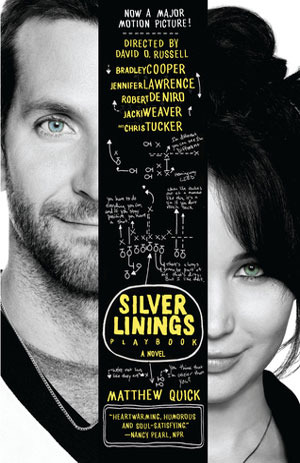Book Review: The Silver Linings Playbook
 The Silver Linings Playbook
The Silver Linings PlaybookMatthew Quick
I am a huge fan of the film, and having watched it numerous times, I felt it was time I read the novel that it is based upon. To my surprise, there were quite a number of differences throughout, and not just the ending. The characters not only have much more depth, but they’re presented differently and more authentic to the experience they’re put in.
The premise of the story
is that Pat, who is put into a mental facility for an indeterminate amount, is
taken out to live with his parents. He’s doing his best to win back his estranged
wife, Nikki, who he hasn’t seen since the incident that he doesn’t remember. He
works out most of the day to get back into shape and spends a lot of time
reading English literature — specifically the books Nikki teaches to her students.
At the same time, he does his best to win back his father’s approval and gain
back a relationship with his brother Jake.
I love this book because
Pat’s point-of-view is written well; we are able to understand his reasoning as
much as he does, and much better than those around him. The main difference
between the film and the book, without giving much spoilers, is that the film is
much more based on romance, as to what I remember, where this is more personal
and about Pat’s recovery. It always has been — but the book shows is much more.
Society may have a
generalised view on mental health, and I think this book portrays it so
realistically. A lot of the suffering may come from not from mental illness
itself, but rather how others, especially close family and friends, treat others
differently. One of my favourite aspects is not that Pat is mentally ill and
everyone else is stable; but really, everyone has their flaws and issues. It
becomes evident in Pat’s friendship with Tiffany, in which they bond in unusual
activities (running all day without talking) and how they’re both treated similarly
by their family. Pat’s household doesn’t come short on this aspect — his
father avoids speaking with him and has had experience of angry outburst; his mother
is constantly crying and upset. These elements are what makes living with
mental health so real; they don’t necessarily need labels or stereotypical
symptoms, but they interweave themselves in the intricacies of daily life and
social relationships.
The story follows a similar outline to the film and is quite pleasant to follow. Reading the book, I was expecting to know the story, and I was still enjoying it on a new level. However, I discovered so many differences, especially with how the last quarter of the book progresses, that it’s almost a novel experience; I had no idea what would happen. This elevated my experience and I recommend this book to be read. There’s not much lost if you’ve previously watched the film. I’m sure I’ll keep on remembering this novel as one of my favourite stories that I’ve ever read or watched.
Sources and Links:
Book: The Silver Linings Playbook
Book Cover: Goodreads
You could give your support by donating to my Ko-Fi or PayPal.me
Advertisements



